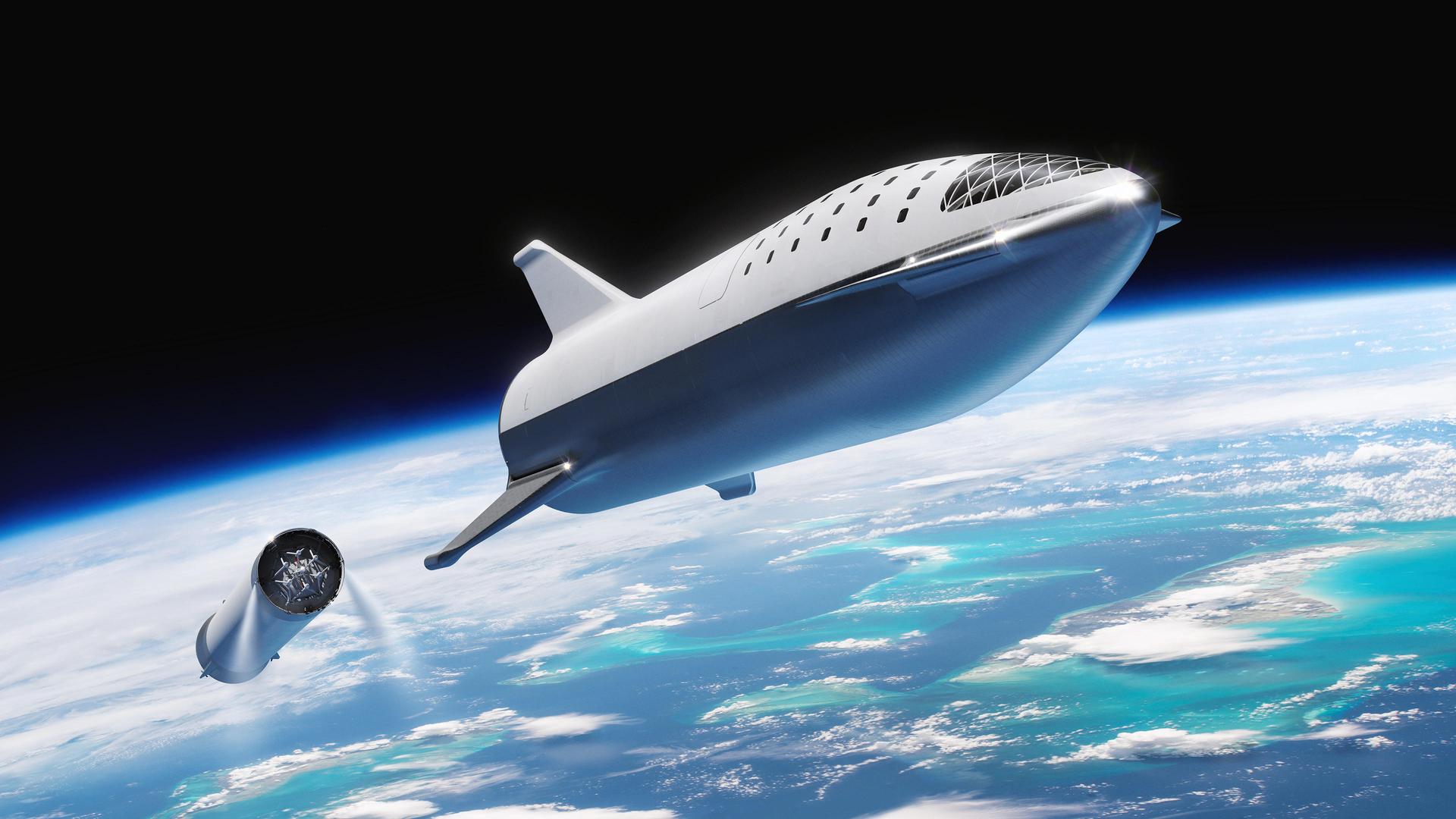Are we in the midst of a new “Space Race”? It certainly seems so from all the international activity – public and private – in areas such as exploration, proposed industrialization, and the planned mining and exploitation of minerals and other elements. There are even strong indications that space is on the verge of being militarized and weaponized. We are close to having to ask the pressing question: Just who’s in charge up there?
◊
Once every 26 months, the orbits of Earth and Mars, our nearest planetary neighbor, bring the two planets into their closest proximity. During this brief window in July 2020, the sky was virtually ablaze with a burst of rocket launches by countries sending spacecraft to the fourth rock from the Sun.
The United States is seeking to maintain its leading role in exploration of the Red Planet. On July 30, NASA launched Perseverance, America's first step in a 10-year program to explore Mars remotely and assess the feasibility of sending crewed missions to Mars.
In addition to the United States, other countries launching Mars space projects in July included China, whose Tianwen-1 mission to Mars lifted off on July 20; and a newcomer to space, the United Arab Emirates (UAE), whose Amal (in English, Hope) mission to Mars got off to a promising start on July 23. One other mission originally slated for this time period was the joint European Space Agency and Roscosmos EXOMars mission, which was postponed to the next optimal window for a Mars launch, late summer, 2022, due to a faulty parachute system for re-entry.
Each of these ambitious missions has unique goals. The UAE sent Amal to explore the Martian climate. China seems to be determined to show off its technological capabilities, carrying on a single rocket both a Mars orbiter and a terrain rover; one of the mission’s primary goals is to examine the planet’s geology in search of signs of life.
The United States is invested in learning whether Mars can be made capable of eventually supporting both plant and human life. As steps toward this goal, the sequence of Mars missions between now and 2030 is designed to experiment with sustainability: that is, the prospects of colonizing our neighbor.
To date, of course, all Mars missions have relied on remotely controlled robotic technologies for experiments. The challenge now is to transition from the pioneering automated missions to direct human exploration. But we Earthlings haven’t solved the challenges posed by human deep-space exploration – yet.
Is This a New Space Race?
Despite all these recent space missions, the four mentioned above represent only a small fraction of activity going on above Earth’s atmosphere. We haven’t yet broached the topics of commercial investment in space projects, nor the U.S. military’s renewed focus on the strategic value of space as made abundantly clear by the newly established Space Force.
Does all this astral activity mean we’re embarking on a new Space Race? At first glance, it certainly seems so. There’s so much new activity above the Earth that there are fears that the planet’s low orbit environment (below 1,200 miles) is becoming an unsafe, trashed zone with so many objects – more than one million of them currently orbiting – that collisions are virtually inevitable.
This controversy is engagingly presented in the MagellanTV documentary Space Smash. Ever since the first launch into space – 1957’s U.S.S.R. launch of Sputnik 1 – literally megatons of spent rocket components have been floating around weightlessly. One issue that has rarely been seriously addressed is whose responsibility it will be to clean up the mess to ensure the safety of future space flights. Will each nation eventually take responsibility for sweeping up its own space junk? Or will the United Nations have to step up to resolve the issue for now and the future?
Among the unusual objects orbiting in space is a school bus–sized observation satellite, named Envisat, sent up by the E.U. in 2002 that’s been floating untethered since April of 2012.
Whether this can be called a "real" Space Race might depend on one’s point of view. To some, the Space Race of 1957–1969 was a unique historical competition between the U.S. and the Soviet Union in their quests to be first to land humans on the Moon. But others would argue that a new multinational race to claim much more than simple bragging rights has commenced. The winners could control territory and previously untapped sources of wealth and dominance that will make the U.S.-Soviet race seem as trivial as a frog jumping contest at a county fair.
Given the high-stakes games China and the United States are playing on Earth’s surface, maybe those two rivals can be seen as the most likely to engage in a prolonged, binary Space Race. Both are focused on the goal of eventually colonizing Mars, and both are making strides toward that end right now.
The U.S. has a long history of virtually unrivalled space dominance (at least since 1969). And China has something to prove: namely, that their technology is superior to the Americans’. It remains to be seen how China will fare when its plans are truly put to the test later in 2020 on a complex mission to the Moon.
BATTLE FOR THE MOON: 1957-1969
Everyone (It Seems) Is Going to the Moon
There are three nations and at least a couple of commercial companies with plans to head to the Moon in late 2020 and early 2021. The U.S., China, and – somewhat surprisingly – India all are prepping lunar missions.
China will launch its Chang’e 5 spacecraft, which includes a lander to set down on the Moon’s surface to collect soil and rock samples. There will also be a sample-return unit that will launch into lunar orbit and robotically link up with the Chang’e 5 for its journey back to Earth. The complexity of the Chinese plans is seen by many to be a dry run for sending a crewed ship on a round trip to the Moon via orbiters and landing/return vehicles.
For its part, India is set to launch its Chandrayaan-3 to the Moon in November 2020. Success is crucial to the ongoing hopes of the Indian space program. The first Chandrayaan mission missed the Moon entirely in 2008, and Chandrayaan-2 crash-landed on the surface in 2019.
Finally, there’s the U.S. and its unmanned Artemis mission to orbit the Moon, scheduled for early in 2021. This is the first step in NASA’s ambitious goal to land “the first woman and next man” on the surface of the Moon by 2024, with the goal of “sustainable” lunar exploration commencing in 2028.
Fly Me to the Moon – Commercially
The lure of outer space to deep-pocketed, for-profit companies (and their billionaire owners) is inestimable. Big names such as Elon Musk, Jeff Bezos, and Richard Branson are all at work on space missions geared to burnishing their bona fides as space explorers – and eventually to raking in large piles of money.
Musk’s SpaceX succeeded in launching a manned mission to the International Space Station (ISS) in late May 2020, and returned its astronauts safely to Earth two months later, in early August. Now, SpaceX’s newly proclaimed “top priority” is Starship, which aims to provide ongoing access to the Moon and beyond, eventually opening up Mars to colonization and becoming a commercial stop for the most intrepid explorers among us.

Artist's rendering of SpaceX Starship jettisoning its booster rocket as it leaves Earth's atmosphere.
(Image Credit: Wikimedia)
SpaceX embarked on another ambitious project in 2020 – Starlink. The endeavor seeks to encircle the Earth with nearly 1,600 communications satellites, creating a celestial web to provide fast and inexpensive Internet access around the globe. Many astronomers have complained that this massive number of new orbiting objects interferes with stellar observations. In response, SpaceX announced in June 2020 a series of tests whose objective is to limit the reflectivity of its satellite.
Where does “outer space” begin? It's not so simple. Generally defined as where Earth's atmosphere ends, some mark the line at 62 miles up, but others counter that 50 miles above sea level is a more appropriate boundary.
A prime goal for these rapidly expanding enterprises, and their capitalistic drive for profit, is space tourism. Branson’s Virgin Galactic has expressed a desire to take paying passengers into space, and his Virgin Orbit proposes to carry passengers on intercontinental journeys by flying supersonic transports into low space. SpaceX, Blue Origin, and Boeing all have active programs to turn paying customers into astronauts. Boeing’s experiment with commercial space travel, its Starliner, is showing some promise, though its progress has been less than fully successful to date.
Perhaps the most obvious – some would say egregious – example of the profit-motivated plans by this new class of “space industrialists” is Jeff Bezos (currently the wealthiest man on Earth). His space venture Blue Origin’s stated objective is to “industrialize” space by setting up manufacturing and construction projects in the zero-gravity environment, as well as to extract water and minerals. As a key step in the enterprise, the company’s Blue Moon lander is expected to fly to the Moon as early as 2024.
Militarizing Space – Is This Everyone’s (Secret) Goal?
With so many governments and commercial enterprises in an apparent headlong rush to establish a foothold in outer space, an obvious question needs to be asked: Who’s in charge up there? Although there is a long-lasting international agreement to keep space demilitarized, there are nations – including the U.S. – that seem to be pushing at the edges of that pact.

Official Seal of the U.S. Space Force (Image Credit: Wikimedia)
With the U.S. military’s new division, Space Force, cleaved off from existing projects and military priorities of the U.S. Air Force, America is continuing to fill the skies with spy satellites and other mysterious flying objects. And both China and Russia have been caught testing projectiles designed to take out other flying spacecraft.
While there may not yet be weapons in space focused on the Earth, recent statements by officials, including the U.S. president, can be read as worrisome. For example, an unnamed Space Force official commented to Space.com that its recent activities allow “the U.S. to more efficiently and effectively develop space capabilities necessary to maintain superiority in the space domain.”
Even the President, somewhat alarmingly, stated, “Space is going to be the future. Both in terms of defense and offense. . . . [We] are now the leader in space.” If the United States is indeed setting its sights on placing weapons in orbit, in violation of the Outer Space Treaty of 1967, we all had better start worrying.
The Future of Space – Domination or Cooperation?
However you look at the future of space and space exploration, it’s clear that the heavens are going to remain congested with humans and their flying objects for the foreseeable future. With so many unanswered questions, harmony and cooperation among nations will be paramount to establishing and maintaining order in the space that lies beyond Earth.
It may seem like the Wild West up there, a frontier that will eventually call out for (space) marshals to civilize the territory. If you remember the 1981 Hollywood feature film Outland, you might worry about a dystopian frontier of space overrun with criminals and victims in dire need of justice. But if carefully and cooperatively implemented, space endeavors could be run in an orderly way with respect for (interplanetary) law and order.
Whatever the future might hold, it’s becoming increasingly clear that space is fraught with inherent dangers, as well as with those other potential risks (industrialization, weaponization) and benefits (cooperation, communication) that we humans seem to carry with us wherever we roam.
Ω
Kevin Martin is Senior Writer for MagellanTV. He writes on a wide variety of topics, including outer space, the fine arts, and modern history. He has had a long career as a journalist and communications specialist with both nonprofit and for-profit organizations. He resides in Glendale, California.

